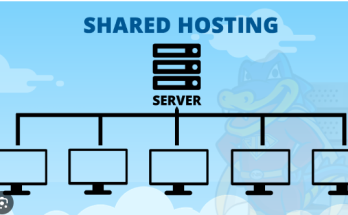Introduction (Approx. 200 words)
- Setting the Stage: Briefly introduce the concept of web hosting and its significance for websites.
- Definition of Shared Hosting: Explain what shared web hosting is and how it differs from other hosting types (like VPS or dedicated hosting).
- Benefits: Highlight the advantages of shared hosting, such as cost-effectiveness and ease of use.
Understanding Shared Web Hosting (Approx. 400 words)
- Technical Overview: Explain the technical aspects of shared hosting, including server resources, bandwidth, and how multiple websites share a single server.
- Resource Allocation: Discuss how resources like CPU, RAM, and storage are distributed among the shared hosting accounts.
- Performance: Address the impact of resource sharing on website performance and speed, including potential drawbacks.
Choosing the Right Shared Hosting Provider (Approx. 400 words)
- Factors to Consider: Discuss the essential criteria for selecting a shared hosting provider, such as uptime, customer support, security measures, scalability, and offered features.
- Comparative Analysis: Compare and contrast different popular shared hosting providers, highlighting their strengths and weaknesses.
- User Reviews: Include insights from user reviews to provide a balanced perspective on various hosting options.
Setting Up with Shared Hosting (Approx. 400 words)
- Getting Started: Walk readers through the process of signing up for a shared hosting plan, from selecting a package to registering a domain name.
- Control Panel Overview: Explain the functionalities of popular control panels (e.g., cPanel, Plesk) used in shared hosting environments.
- Installing Applications: Provide a step-by-step guide on installing common applications like WordPress or Joomla using the hosting control panel.
Managing a Shared Hosting Account (Approx. 400 words)
- Managing Resources: Offer tips on optimizing resource usage in a shared hosting environment to ensure the smooth running of websites.
- Security Measures: Discuss essential security practices and tools to safeguard websites hosted on a shared server.
- Troubleshooting: Address common issues users might encounter with shared hosting and suggest troubleshooting steps.
Scaling Beyond Shared Hosting (Approx. 400 words)
- Recognizing Limits: Explain the signs that indicate when it’s time to consider moving from shared hosting to other hosting options (VPS, dedicated hosting).
- Migration Process: Provide guidance on migrating from shared hosting to more advanced hosting solutions.
Conclusion (Approx. 200 words)
- Recap: Summarize key points covered in the article regarding shared web hosting.
- Final Recommendations: Offer closing remarks and recommendations for readers exploring shared hosting solutions.
Title: The Comprehensive Guide to Shared Web Hosting Services: Everything You Need to Know
Introduction:
In today’s digital landscape, establishing an online presence is pivotal for businesses and individuals alike. Shared web hosting services have emerged as a popular and cost-effective solution for hosting websites. This comprehensive guide aims to elucidate the concept of shared web hosting, its advantages, considerations, and how it operates.
1. Understanding Shared Web Hosting:
Begin by defining shared web hosting. It involves multiple websites sharing a single server’s resources, such as CPU, RAM, and storage space. Discuss its affordability and how it suits small to medium-sized websites and beginners due to its cost-effectiveness.
2. Pros and Cons:
Pros:
- Cost-effectiveness: Elaborate on how shared hosting plans are budget-friendly.
- User-Friendly: Discuss how easy it is to set up and manage.
- Technical Maintenance: Highlight how the hosting provider handles server maintenance.
Cons:
- Resource Limitations: Explain how resource allocation can be restricted.
- Performance Issues: Discuss how high traffic on one site can affect others.
- Security Concerns: Briefly touch upon security risks associated with sharing servers.
3. Features to Look for in a Shared Hosting Plan:
Discuss essential features users should consider when choosing a shared hosting plan.
- Bandwidth and Storage: Explain the significance of adequate resources.
- Uptime Guarantee: The importance of a reliable server uptime.
- Customer Support: Emphasize the need for responsive customer service.
- Security Measures: SSL certificates, malware scanning, etc.
4. Steps to Choose the Right Shared Hosting Provider:
Research and Comparison:
- Conducting thorough research: Highlight how users should compare different providers based on features, user reviews, and reputation.
- Consideration of Scalability: Discuss the importance of choosing a provider that allows scaling up when needed.
5. Setting Up a Website on Shared Hosting:
Registering a Domain:
- Explain how to choose and register a domain name.
- Connecting the Domain: Guide readers through the process of linking the domain with the hosting account.
Uploading and Managing Content:
- Using Control Panel: Explain how to navigate cPanel or other control panels provided by the hosting service.
- Uploading Files: Step-by-step instructions on how to upload website files.
6. Best Practices for Optimizing Shared Hosting Performance:
- Caching: Discuss the significance of caching plugins or tools.
- Content Delivery Network (CDN): Explain how CDN helps in enhancing site speed.
- Regular Backups: Emphasize the importance of backing up website data regularly.
7. Troubleshooting Common Issues:
Slow Loading Times:
- Discuss potential causes such as oversized images or inefficient code.
- Provide solutions like optimizing images and using caching plugins.
Security Breaches:
- Tips on enhancing website security, like keeping software updated and using strong passwords.
Conclusion:
Summarize the key points discussed in the article. Emphasize the suitability of shared hosting for beginners and small businesses while acknowledging its limitations. Encourage readers to make informed decisions when choosing a hosting provider.
Title: The Comprehensive Guide to Shared Web Hosting Services
Introductory Paragraph (150 words): In the expansive world of web hosting, shared hosting stands as a popular and accessible choice for individuals and small businesses looking to establish an online presence. This guide aims to delve into the intricacies of shared web hosting, elucidating its definition, functionalities, benefits, and potential drawbacks. By the end, you’ll have a comprehensive understanding of whether shared hosting aligns with your web hosting needs.
1. Understanding Shared Web Hosting (250 words): Shared web hosting refers to a hosting environment where multiple websites share a single server’s resources. This cost-effective solution allows websites to coexist on the same server, sharing resources like CPU, RAM, and disk space. Users typically manage their sites via a control panel provided by the hosting provider.
2. Advantages of Shared Hosting (300 words): One of the primary advantages of shared hosting is its affordability, making it an ideal choice for beginners or small businesses with limited budgets. Additionally, providers often offer user-friendly interfaces and customer support, simplifying website management for non-tech-savvy users. Moreover, shared hosting providers handle server maintenance, reducing the user’s administrative responsibilities.
3. Limitations of Shared Hosting (300 words): Despite its benefits, shared hosting has limitations. Sharing resources among multiple websites can lead to performance issues during traffic spikes on other sites hosted on the same server. Furthermore, limited customization options and security concerns due to sharing the server with other users are notable drawbacks.
4. Choosing the Right Shared Hosting Provider (350 words): Selecting the appropriate hosting provider is crucial. Factors to consider include uptime guarantees, customer support quality, server location, scalability options, included features (such as email accounts, SSL certificates, etc.), and user reviews. Assessing these aspects ensures a reliable hosting service that aligns with specific website requirements.
5. Optimizing Performance in Shared Hosting (300 words): Implementing performance optimization techniques can mitigate the limitations of shared hosting. Utilizing caching mechanisms, optimizing images and scripts, minimizing plugins, and monitoring website traffic can significantly enhance site performance within the shared hosting environment.
6. Security Measures in Shared Hosting (300 words): To bolster security in a shared hosting setup, users should prioritize measures like regular software updates, strong passwords, utilizing firewalls, and considering additional security tools offered by hosting providers. Implementing these strategies helps safeguard websites against potential vulnerabilities.
Conclusion (200 words): Shared web hosting serves as an accessible entry point into the online realm for many aspiring website owners. While it has its limitations, understanding its dynamics allows individuals and small businesses to make informed decisions regarding their hosting needs. By considering the advantages, limitations, and strategies for optimization and security, users can navigate the shared hosting landscape more effectively.



